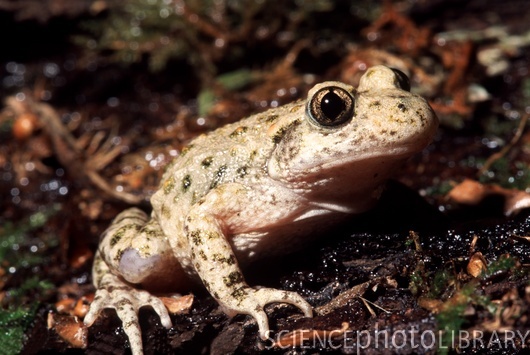Kammerer, a leading proponent of the Lamarckian theory of evolution, achieved global prominence in the 1920's by arguing that acquired traits could be passed down through generations and, in his most controversial experiment, forced land dweller midwife toads to live in water. Their offspring preferred to live and mate in water and by the third generation he noted that they began to develop black nuptial pads on their forelimbs, a feature common to water dwelling species.
In 1926 Kammerer fell into disgrace when it was found that his only remaining fixed specimen had been injected with India ink to produce the appearance of the black nuptial pads. Kammerer's role in the alleged fraud was never proven and six weeks after its discovery he committed suicide. Eventually, a naturally occurring specimen with nuptial pads was found, demonstrating that midwife toads do have the potential to develop them.

Common midwife toad. (Alytes obstetricans almogavarii). This toad is found throughout Europe and Northwest Africa. Its name is derived from the male's habit of carrying the fertilized eggs on its back. When the eggs are due to hatch, the male carries the eggs into the water where the tadpoles can emerge. Credit: BRIAN GADSBY / SCIENCE PHOTO LIBRARY - © This image is for this illustration only and subject to copyright and may not be reused or copied in any way without prior permission from Science Photo Library.
Writing in The Journal of Experimental Zoology, Dr. Alexander Vargas from the University of Chile says that Kammerer was actually decades ahead of his contemporaries and should be considered the founder of epigenetics.
Vargas re-examined Kammerer's experiments finding remarkable resemblances to newly discovered aspects of epigenetics, which studies influences in inheritance beyond the DNA sequence.
"Today Kammerer's scientific legacy is non-existent and he is often cited as an example of scientific fraud," said Vargas. "However, the specific similarities of Kammerer's experiments to epigenetic mechanisms are very unlikely to have been the result of his imagination. These new biological arguments provide a modern context suggesting that Kammerer could be the actual discoverer of epigenetic inheritance."
Vargas says he has studied Kammerer's evidence, as summarized in his 1920's research notes, and found that Kammerer reported hybrid crosses of treated and untreated toads in which 'parent-of-origin effects' can be observed, a recurrent phenomenon in epigenetics. Kammerer also reported that his toads developed larger bodies than untreated land toads and that their eggs were smaller and contained less egg-yolk than normal. These are traits that are known to be influenced by epigenetic mechanisms.
Building on these observations Vargas proposes a preliminary model based on current knowledge of epigenetics to explain the midwife toad experiments, which illustrates how in a modern context an explanation can be offered for results which appeared utterly mysterious to Kammerer and his contemporaries.
Kammerer's consistency with current epigenetic mechanisms provides new and compelling biological arguments in favor of the authenticity of the midwife toad experiments, says Vargas.
"New experimentation on this species with the advantage of modern molecular-genetic tools could mean an end to the controversy," added Vargas. "If Kammerer's data is correct, the midwife toad holds the potential of becoming an excellent model system for studying epigenetics and especially its evolutionary implications."
Article: Vargas A, 'Did Paul Kammerer discover epigenetic inheritance? A Modern look at the controversial midwife toad experiments', J Exp Zool Mol Dev Evol, Wiley-Blackwell, August 2009; DOI:21319





Comments